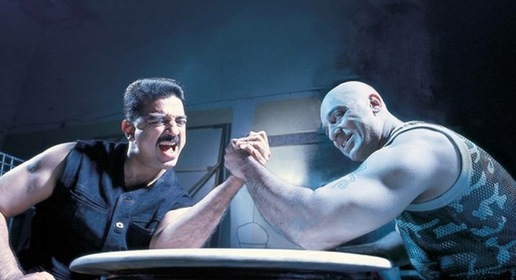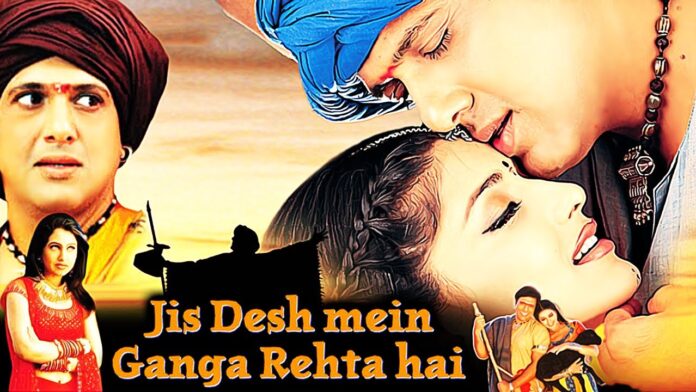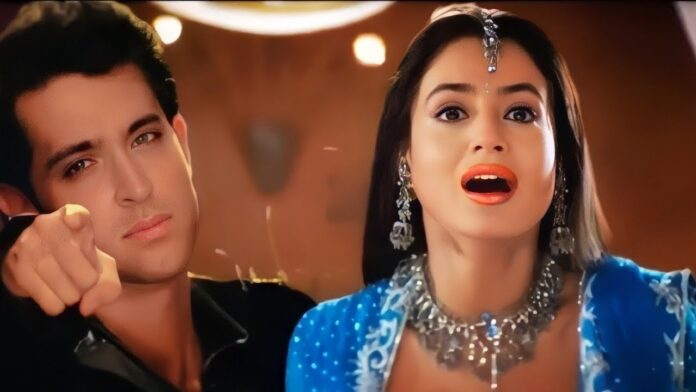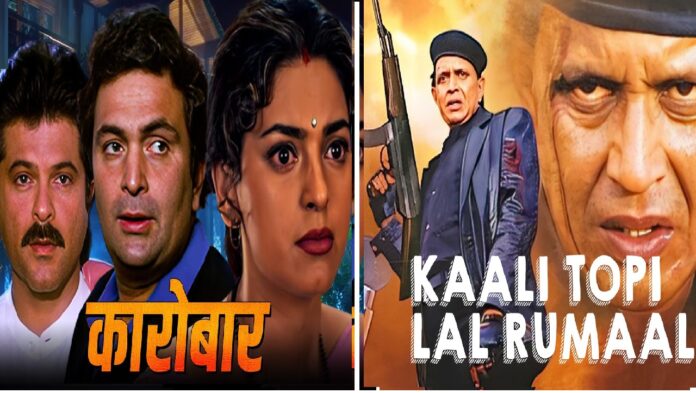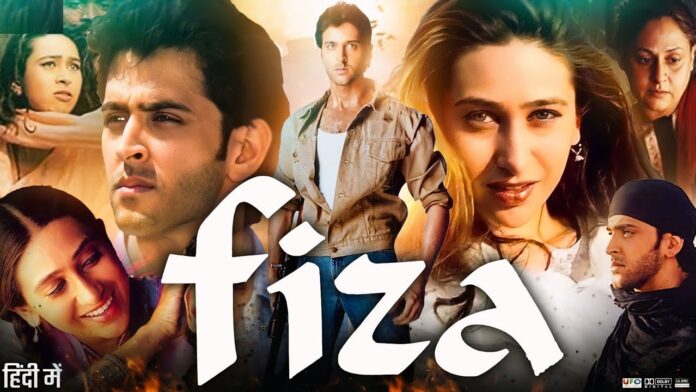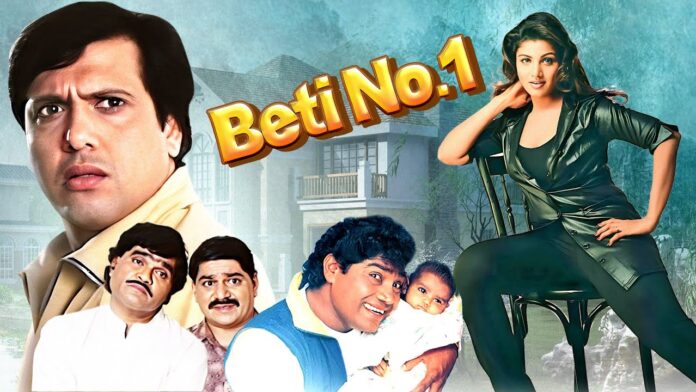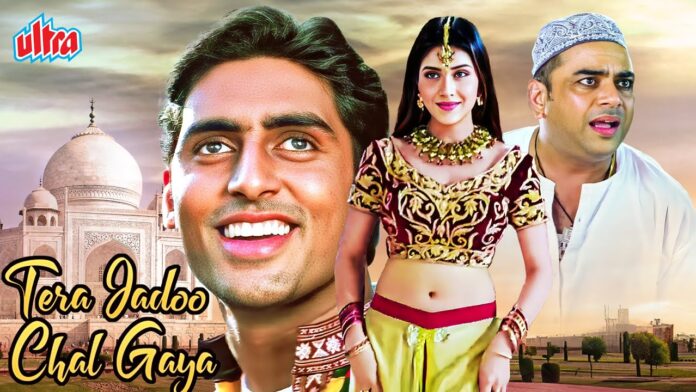SHOOTING COVERAGE
KAMAL HAASAN LAUNCHES ‘ABHAY’
All About The ‘Monkey’ Hiding Inside Us
7.30 p.m. 18th October, 2000. Nehru Indore Stadium, Madras.
The stage is set. Two big cut-outs of the superstar — one each of the two roles he plays in the film — on the left and right sides of the stage attract a lot of attention. Three huge video screens — one at the centre of the stage and one each at the further left and right of it — look set to come alive any moment. A crowd of thousands waits impatiently for the on-stage appearance of their favourite star. Invitees, seated in the foreground, and the fans, seated at the back on the multi-tiered balcony, animatedly note the arrival of every single VIP.
8.00 p.m. The lights go off. The crowds begin to roar in anticipation of the show’s beginning. They would go into a frenzy. Any moment. But not yet.
It is the launch function of the latest Kamal Haasan starrer, Abhay.
The invitee list seems to be the Who’s Who of Tamil filmdom. Among the more notable people present to wish the Abhay team luck at the start of the film are superstar Vijaykanth, filmmakers K. Vishwanath, Bharathiraja, Mani Ratnam, Priyadarshan and Malayalee filmmaker Shaji Kailash (who is now also making a film in Tamil). Representing the Hindi film industry are filmmakers Ramesh Sippy and Sanjay Leela Bhansali, apart from Raveena Tandon, Javed Akhtar, Shankar-Ehsan-Loy and art director Sameer Chanda, who are all involved with the film.
The extravaganza begins!
Huge speakers blare the theme song of the film. It has been recorded over a four-day schedule in Bombay which concluded just a day before the launch. The song is powerful, making the listener feel the tension that underlines the subject of the film. Dancers fill the stage. Soon after a superb performance, the formal function begins.
One by one, a guest and a member of the crew are invited on the stage in pairs. A memento is presented to each of the guests, and a bouquet is given to every unit member. Each arrival on the stage is accompanied by the person’s show-reel playing on the video screens. Some of the clips are from Kamal Haasan starrers. The fans bring the house down every time his face appears on the screens.
But where is the superstar hiding? The fans begin to grow restless, but manage to control their charged emotions till all the introductions are over.
They don’t have to wait too long. Even before the emcees finish introducing the legend of Tamil cinema, the crowds go into raptures. Then, he makes a grand appearance. Dressed in a light formal suit, Kamal Haasan looks suave as ever. The moment he steps onto the stage, all hell breaks loose. He has to wait several moments before he can speak as the crowds have not finished cheering him. He thanks his guests and fans and everyone present at the function. He calls each of the celebrity invitees on the stage. “This is my turn to ask for a photo opportunity with everyone,” says he amidst peals of laughter.
When everyone arrives on stage, Haasan breaks into singing the national anthem. The crowds hurriedly rise to their feet.
End of show.
Total expense: Rs. 54 lakh!
About The Film
Trust Kamal Haasan to do this. The front page of the brochure of Abhay shows Kamal Haasan, sitting crouched completely in the nude. ‘Shocker’ is the first word that comes to mind. “Ha! Ha! It all depends on what we are exposed to. Thanks for the compliment anyway!”, quips Kamal when told so.
The chat is taking place just a few hours before the launch of the film which stars Kamal Haasan in a double role. It is being directed by Suresh Krssna, the superhit director down South. He is rather well-known for making two Tamil Rajinikanth blockbusters — Annamalai and Baasha. However, he has not quite found success in Bollywood. Both the Hindi films — the Salman Khan-Revati starrer, Love, and the Salman-Karisma starrer, Jagruti — turned out to be box-office duds. Notwithstanding this, Kamal has reposed a lot of faith in the director and has saddled him with the responsibility of executing his latest.
Abhay is an ambitious project. Firstly, it is a double version film. (The Tamil version is titled Aala Vandaan — ‘Came To Conquer’.) Meaning, the film will be shot simultaneously in Hindi and Tamil. Pleads the director, “Please do not mistake this to be a dubbed film. Both versions are going to be shot separately, though in the same schedule. We have taken utmost care in deciding the cast of the film so that we achieve a balance therein. The film will have artistes from both, Hindi and Tamil films. Raveena Tandon plays the main lead opposite Kamal Haasan.” Among the other Hindi film artistes who will appear in the film are Manisha Koirala, Smita Jayakar and Vikram Gokhale. The director continues, “We have kept the tastes of both the audiences in mind while deciding on the costumes of the film, again, so that the film’s look doesn’t appear too one-sided.”
Abhay will be replete with special effects including computer graphics. It will include a total of about fifteen minutes of computer graphics sequences — featuring some of the kind never seen before in Indian films. The special effects and CG will be executed by a specialist Australian company, Cutting Edge. Its track record includes animation and other effects for Hollywood films like Beastmaster and Komodo. David Peers, the company’s visuals effects supervisor, will oversee the entire shooting stint of the film. He informs that Abhay will have countless special effects, including freezing time, realistic CGI and others. Both the characters played by Kamal Haasan in the film will actually appear as if they are two separate persons. The effects alone are likely to cost a whopping “Rs. 1.3 crore”.
To further lend the film international standards, there are the stunts which will be designed by Grant Page. The man’s past record includes blockbusters such as Mad Max (parts I and II) and Jackie Chan starrer Mr. Nice Guy.
All of this makes it the costliest project the film’s producer, Kalaippuli S. Thanu, has ever undertaken. He only recently made the Tabu-Aishwarya starring Tamil film, Kandukondain Kandukondain, at a cost of about Rs. 7 crore. He, however, prefers to duck answering if Abhay will be the costliest film ever made down South.
Kamal Haasan recently finished writing the screenplay and the Tamil dialogues of Abhay. The seed came from a novel he himself wrote nearly 17 years ago! At the time, he was shooting for a Hindi film — the name of which he has trouble recollecting — in Bombay. Flashback: “I had to report daily on the sets at 9 a.m., whether I was needed or not. I would generally have to wait around three hours every day before they called me for the shooting. One day, I got tired of just lousing around. Which is when I started writing this story. It was serialised in a Tamil newspaper and lasted 36 weeks!” Although Abhay is an adaptation of the novel, Kamal has taken due care in giving the film a fresh approach. He has worked hard at etching out both his characters — one, Major Vijay, who stands for the Good, and the other, Abhay, for Evil. Raveena plays an NDTV news reporter, Tejasvini Varma, who is also the fiancée of Vijay.
“I was fascinated by the two characters when Kamal first told me the story,” says Javed Akhtar who is writing the Hindi lyrics of the film. He adds, “Normally, a character in our films is shown feeling only one emotion at a time. But there’s not one sequence in the film where Kamal’s character (Abhay) is not experiencing at least two-three contrasting emotions — that too, at the same time! Naturally, this makes the character very unpredictable. Hence, my fascination with it.”
Kamal hastens to add, “The whole idea behind Abhay is to expose the hypocrisy behind the so-called fearlessness. Nobody is fearless. My character in the film starts out as one and realises the same truth about himself in time.” Another thing about the subject that attracted Kamal was the hidden evil “which is inside all of us”. He insists, “Of course, we generally manage not to act on our evil impulses… mainly due to societal pressure. But the fact still remains that there is a ‘monkey’ lurking inside all of us.” He adds jocularly, “….and I’m not being zoological here!”
Abhay is not about schizophrenia or anything as such, insists the legendary star who has won accolades for more films than he cares to remember. “Instead, it is a film that revolves around sibling rivalry. It is about two people with similar faces but dissimilar faiths. More than the technique, it will be interesting to learn whether we are able to peel the layers and get deep under the skin of the characters. That’s where the true challenge for me as a writer and as an actor lies,” he concludes.
The film is being shot in a single schedule — in Madras, Ooty and New Delhi. Shooting began on 19th October in Madras and will be over by 15th January, 2001. The makers hope to release the film in April 2001.
– RAJ VAIDYA
LATEST POSITION
Last week’s release has been written off. All eyes are now on the two mega films of Diwali.
Jis Desh Mein Ganga Rehta Hai is very bad almost everywhere. 1st week Bombay 70,27,064 (80.95%) from 16 cinemas (7 on F.H.); Jamnagar 91,642 (1 in matinee unrecd.); Pune 12,52,618 from 6 cinemas, Solapur 2,46,418 from 2 cinemas (1 in matinee), Satara 1,58,922; Delhi 33,23,160 (41.71%) from 12 cinemas (2 on F.H.); Kanpur 2,76,723 from 2 cinemas, Lucknow 3,88,913 from 2 cinemas, Agra 2,35,415, Varanasi 1,76,715, Allahabad 1,54,840, Bareilly (6 days) 90,320 (32.62%); Calcutta 8,99,826 from 5 cinemas (others undisclosed); Nagpur 4,83,290 from 4 cinemas, Jabalpur (6 days) 92,744, Akola 1,54,665, Raipur (6 days) 1,11,924, Yavatmal 81,056; Indore 1,80,000 (3 on F.H.), Bhopal 1,28,823 (1 unrecd.); Jaipur 6,05,226 (37.56%) from 3 cinemas, Ajmer (gross) 2,27,785, Bikaner 1,77,526; Hyderabad (gross) 23,36,455 from 12 cinemas.
X-Men (dubbed) 1st week Bombay 2,21,814 (21.86%) from 2 cinemas (2 unrecd., 3 on F.H.); Agra 1,20,000; Amravati 90,809, Jalgaon 83,382.
…………..
Shikari has crashed. 2nd week Bombay 10,29,811 (34.73%) from 6 cinemas (7 on F.H.); Jamnagar (matinee) 11,870 (1 in regular unrecd.); Pune 3,23,392 from 5 cinemas (1 in matinee), Solapur 1,13,100 from 2 cinemas (1 in matinee), Satara (matinee) 35,268; Delhi 4,35,825 from 4 cinemas; Kanpur (6 days) 1,01,419 from 2 cinemas, Lucknow 1,03,745, Agra 1,78,000, Varanasi 80,200, Allahabad 66,000, Hardwar 25,000; Calcutta 2,45,035 from 4 cinemas; Nagpur 1,42,566 from 3 cinemas, Jabalpur (6 days) 32,677, Amravati 83,872, Raipur 33,517, Jalgaon 74,898, 1st week Gondia (gross, 6 days) 61,948; 2nd week Jaipur 1,46,787 (17.31%) from 2 cinemas, Bikaner 68,204; Hyderabad (gross) 1,53,665 from 2 cinemas (1 in noon).
Aaghaaz nears its end in 2nd week! 2nd week Bombay 11,90,931 (46%) from 6 cinemas (7 on F.H.); Pune 2,60,217 from 3 cinemas, Solapur 1,02,000; Delhi 1,43,710 (1 unrecd., 2 on F.H.); Kanpur (6 days) 1,12,156 from 3 cinemas, Lucknow 79,352, Agra 84,398, Varanasi 70,615, Allahabad 58,731, Bareilly (6 days) 47,235 (16.47%); Calcutta 9,10,043 from 16 cinemas; Nagpur 94,061 from 2 cinemas, Jabalpur (6 days) 32,677, Amravati 95,190, Akola 53,037 (1st 1,46,000), Raipur (6 days) 88,716, Jalgaon 81,988 (1st 1,16,839); Bikaner 47,621; Hyderabad (gross) 4,02,691 from 3 cinemas.
…………..
Astitva is also dull. 2nd week Bombay 10,20,186 (44.94%) from 4 cinemas (3 on F.H.); Delhi 4,78,277 from 4 cinemas; Lucknow (7 shows) 29,453; Calcutta 1,17,152.
Dhaai Akshar Prem Ke 3rd week Bombay 4,99,089 (34.40%) from 4 cinemas (4 on F.H.); Pune 2,49,182 from 4 cinemas (1 in matinee, 1 unrecd.), Solapur 40,813; Delhi 4,88,384 from 4 cinemas (1 on F.H.); Kanpur (6 days) 46,966, Lucknow 1,29,461, Agra 55,000, Varanasi 60,520, Allahabad 53,632, Bareilly 37,891 (11.61%); Calcutta 3,53,457 from 3 cinemas; Nagpur 39,877, Jabalpur (6 days) 29,482, Amravati 92,060, Akola 38,600 (2nd 68,359), total 2,37,703, Raipur (6 days) 41,004, Bhilai (6 days, gross) 62,257, Jalgaon 56,722, total 2,87,409, Wardha 32,219, Chandrapur 67,097, total 3,40,617, Yavatmal 40,043; Bhopal 41,952; Jaipur 97,942 (13.55%); Hyderabad (gross) 2,22,954 from 2 cinemas (1 in noon); Mangalore 1,87,265; 1st week Guntur (5 days, gross) 39,866.
INDUSTRY STATUS FOR FILM BUSINESS NOTIFIED
The central government on 17th October notified that film business is an industry, thereby formally completing all formalities in according industry status to film trade.
Showbiz had been accorded industry status on 10th May, 1998 and a formal announcement to that effect had been made the same day at a conference organised by the Federation of Indian Chambers of Commerce and Industry (FICCI) on the entertainment industry, more specifically, on challenges before Indian Cinema.
The announcement of the notification was also made at a FICCI-organised interactive meet on 18th October at The Regent, Bandra, Bombay. Coincidentally, Sushma Swaraj made the declaration in 1998 and it was she again who declared about the notification this week. She was the I & B minister in 1998 too as she is now, having come in place of Arun Jaitley.
The interactive meeting of 18th October was also attended by Union finance minister Yashwant Sinha who delivered a well-meaning speech. He promised to look into the demand of the industry for uniform entertainment tax in all the states of the country.
After the interactive meeting, the two ministers were felicitated by the All India Film Producers’ Council.
DIWALI GIFT FOR DELHI-U.P. TRADE?
The Delhi-U.P. trade is likely to get a terrific Diwali gift from the Uttar Pradesh government.
Entertainment tax, which is currently 100%, is to be reduced to 60%. An announcement to this effect will be made very shortly, it is learnt.
The Motion Pictures Association (MPA), Delhi, has been in negotiations with the U.P. government to bring down the exorbitant rate of entertainment tax. Just recently, G.D. Mehta, G.S. Mayawala and others of the MPA called on U.P. minister Hukam Singh who promised them relief in entertainment tax, it is learnt.
The tax, which was 150%, was brought down to 125% and then to 100%. It is expected that it will now come down by a further 40%.
MPA SEEKS LAND ALLOTMENT IN NOIDA FOR FILM CITY, INSTITUTE
The Motion Pictures Association (MPA), Delhi, has written to Uttar Pradesh chief minister Ram Prakash Gupta, asking his government to help it acquire 50 acres of land in NOIDA from agriculturists. Explaining that the land would be used to set up a Film City and start a film training institute, the MPA has requested the U.P. government to notify and release land for the purpose.
The letter, dated 10th October, states that the MPA will pay the cost of the land and nominal development charges, if any, imposed by the state government. It is made clear that the MPA and its members were willing to invest Rs. 50 crore in the proposed project. The MPA intends to shift its administrative office in the vicinity of the proposed Film City. Distributors, too, would shift base there.
ASSAM DISTRIBUTORS TO DEDUCT 20% OF PRICE ON DELIVERY
The distributors section of the Assam branch of the EIMPA (Eastern Indian Motion Pictures Association), Calcutta, on 16th October passed a resolution which allows all members who acquire distribution rights of Hindi films for Assam, to deduct 20% of the price at the time of taking delivery of films from producers. The resolution, which was put into effect yesterday (20th October), comes in the wake of a ban on the exhibition of Hindi films in the state of Manipur. It was also resolved that once the screening of Hindi films in Manipur resumed, the distributors would pay the respective producers the deducted amount within 15 days.
Another resolution, passed the same day, asked the producers not to grant film distribution rights for 16mm prints till a period of 2 years from the release date of the film in Assam.
TWO-WAY REVISION OF ADMISSION RATES AT GAIETY-GALAXY
Many cinemas across the country will effect hikes in their admission rates next week to take advantage of the immense craze for Mohabbatein and Mission Kashmir, both scheduled for release on Diwali.
But Manoj Desai of Gaiety-Galaxy (G-7) cinema complex at Bandra, Bombay, will reduce admission rates partly and increase them partly.
At Gaiety and Galaxy, there will be an additional class created, besides the existing balcony and stalls. The admission rate in the new class — family circle, created in the stalls class — will be Rs. 5 more than the current rate of stalls. Simultaneously, the rate for stalls will be down by Rs. 5 and for balcony, up by Rs. 5. Therefore, as against the present Rs. 40 (stalls) and Rs. 50 (balcony) rates, the new rates will be:- stalls Rs. 35, family circle Rs. 45 and balcony Rs. 55.
Resultantly, the nett weekly capacity of Gaiety will increase by Rs. 47,000 and of Galaxy, by Rs. 38,000. Mohabbatein is due at Gaiety, and Mission Kashmir, at Galaxy.
In Gemini, the single-class cinema, there will now be two classes — executive class with an admission rate of Rs. 55, and economy class (Rs. 45). The current single rate is Rs. 50. The change will see the nett weekly capacity go up by Rs.10,000.
There will be a Rs. 5 increase in admission rate of Gossip. The new rate for the 105-seat cinema will be Rs. 55. Life Is Beautiful (E.) will open in daily 3 shows at the cinema. Kairee will be screened in matinee shows.
NEW ADMISSION RATES FOR ‘MOHABBATEIN’ IN NAGPUR
Admission rates are being hiked in Nagpur for Yash Chopra’s Mohabbatein, due next week. At Liberty, the balcony, reserve and first class rates will be Rs. 50, Rs. 30 and Rs. 15 respectively in place of the present Rs. 30, Rs. 20 and Rs. 10 respectively. The new nett capacity per show will be Rs. 18,090.90 (current: Rs. 11,342.50). Nett for 21 shows (only 3 shows will be conducted per day) will be Rs. 3,79,908.90. The current nett for 28 shows is Rs. 3,17,590.
At Jaswant 70mm, the rates in all classes will be hiked by Rs. 2. A balcony ticket will cost Rs. 22, dress circle Rs. 17 and reserve class Rs. 12. The new nett for 1 show will be Rs. 11,958.20 (present: Rs. 10,440). Nett for 21 shows: Rs. 2,51,122.20. The current nett capacity for 28 shows is Rs. 2,92,320.
The rates in the special box and in the box classes of Panchsheel cinema will be increased by Rs. 10 whereas in the balcony and reserve classes, by Rs. 5. No hike will be effected in the first class rate. The new rates will be Rs. 45 (special box), Rs. 42 (box), Rs. 35 (balcony), Rs. 20 (reserve) and Rs. 10 (first class; unchanged). The nett capacity per show and for 21 shows will be Rs. 14,528 and Rs. 3,05,088 respectively. The current nett for 28 shows is Rs. 3,30,500.80.
CINE PLANET TO OPEN ITS DOORS ON OCT. 27
Cine Planet, a two-screen state-of-the-art cinema, has come up at Sion, Bombay, where Rupam cinema once stood. The cinema is owned by Rasesh Kanakia who had earlier constructed the three stately cinemas — Cinemax, Cine Star and Cine Magic. The two cinemas at Sion are named Planet 1 and Planet 2. They are equipped with the latest and imported sound system, CP 615.
The cinema complex will have a special baby care unit to keep the toddlers amused with their share of entertainment while their parents enjoy a film. For the toddlers, there will be a lot of toys to play with. They will be treated to a number of cartoon films too.
The two cinemas will be inaugurated on 27th October. Planet 1, which will screen Hindi films, will open with Mohabbatein, and Planet 2 will project English films with Dinosaur as the opening attraction.
Planet 1 has 327 seats. The admission rates are: Rs. 50/- for special class comprising 216 seats; Rs. 60/- for executive class having 97 seats; and Rs. 80/- for VIP box, to seat 14.
Planet 2 has 216 seats with an admission rate of Rs. 50 each for 206 seats. The VIP box will have 10 seats for which the admission rate will be Rs. 80.
Kanakia Cine Line Cinemas will control Cine Planet. This newly-formed company of the Kanakias will also take control of their other three cinemas once their period of contracts with the present controllers concludes.
‘BETI NO. 1’ ‘RELEASED’ IN GONDIA!
The Gondia police seized a CD of Beti No. 1 (an unreleased film), a CD player, a large screen, an Entel video projector and other accessories — totally valued at Rs. 2.05 lakh — in a raid conducted on Vandana Video Cinema at Tiroda in district Gondia. The owner of the video cinema has been arrested. The raid was conducted at the instance of Deshpande, the representative of Vishnu Films, Amravati, who are the C.P. Berar distributors of Beti No. 1.
Since last year, about 100 video cinemas have mushroomed in Gondia, Bhandara and Nagpur district. These cinemas have been openly showing new films on big screens installed in their premises. The local police do not take any cognisance of the complaints. Deshpande, therefore, took the help of the police force from Gondia and conducted the raid on the said video cinema.
It is believed that the operators of video cinemas procure the VCDs and cassettes of new films from Raipur, much before the film’s theatrical release.
GRAND JAIPUR MULTIPLEX IN BOMBAY
The Suranas of Raj Mandir Cinema, Jaipur, Padam Sacheti (son-in-law of CCCA president Santosh Singh Jain) and diamond merchant Kothari have joined hands to build a multiplex in Bombay at Jogeshwari on S.V. Road. Bhoomi pujan of the multiplex was held on 18th October and was well-attended.
The multiplex, to be as lavish as Raj Mandir cinema of Jaipur, will have four screens and a total seating capacity of 1,800. There’ll be a banquet hall and a restaurant too. The basement will be used as car parking space and will be able to house 150 cars.
Construction work at the site will begin in a couple of days. The state-of-the-art multiplex will take about 15 months to complete. It will be called Jaipur Multiplex.
Santosh Singh Jain formally dug the first piece of land after the puja. Kamal Kumar Barjatya cracked the auspicious coconut. Bharat Shah lit the lamp. Santosh Singh Jain’s son, Jitendra Jain, specially flew from Indore to attend the bhoomi pujan.
YOU ASKED IT
How many prints of an ‘A’ grade film are normally taken out by Overseas distributors?
– For an ‘A’ grade set-up, about 90 to 110 prints are generally taken for Overseas.
Do exhibitors share the tax-free service charge with distributors? If not, should distributors stake a claim for a part of the service charge?
– Generally, exhibitors don’t share the service charge with distributors.
How much of destiny, talent and looks make a star? Please answer in percentages.
– Talent 50%; destiny 30%; looks 20%.
3-E
Education-Entertainment-Enlightenment
Kaho Naa…Hum Saath-Saath Hain
Rajshri’s next may star Hrithik Roshan after all. Sooraj Barjatya will give a narration of the subject of his new film to Hrithik on 25th October. The film, it may be recalled, is a love story and will star two heroes and one heroine.
The Need To Feed
Nobody must have been as enthusiastic about ‘feeding’ cinemas as our dancing hero. He ‘tore’ tickets of his recent release in cinemas of Bombay in advance! That is to say, when he realised that the film (which had taken a dull start) was not showing any signs of picking up, he instructed several cinemas to ‘manage’ house-full shows from Monday onwards — of course, at his expense! That’s the game to keep intact one’s fame!! Or is it?!?
‘Love’ly Advance Booking
That Aditya Chopra’s Mohabbatein should open to bumper houses next Friday (October 27) can now safely be presumed. No, not because it has two superstars, Amitabh Bachchan and Shah Rukh Khan, together. Not even because its music is catching on in popularity.
It’s because the advance booking for the film has already opened. Not in Bombay, but in two centres of C.P. Berar viz. Raipur and Akola. Such was the craze for the film that when the plans opened on 15th October (Sunday) at Raj Talkies in Raipur and at Vasant Talkies in Akola (both cinemas of the Rathi group), tickets of each and every show of the first three days were sold out in just two days!
Considering that many in the film trade and among the public, too, had written off the film’s music and predicted doom for the film, Aditya and Yash Chopra must now be having the last laugh.
Ad-Mission Kashmir
Come Diwali and ticket rates at the main cinema halls in almost every city will be hiked. Heralding the price-rise are two big films which release in the Diwali week — Mohabbatein and Mission Kashmir. The ‘dubious’ distinction of the cinema with the highest admission rates in the country will be claimed by Bombay’s elite theatre, Metro. The cinema will screen Mission Kashmir with a revised rate of — hold your breath! — Rs. 150 for the Dress Circle class! Stalls tickets will cost Rs. 60, and Balcony, Rs. 100.
And would people still buy cinema tickets at such exorbitant rates? “Absolutely,” declares Nester D’Souza, the affable manager of Metro, his confidence being seconded by the constantly ringing phone line.
What Nester means is that for one, it is the festive season. Secondly, there is great hype around Mission Kashmir. The music, too, has caught on well and Hrithik, of course, commands a super-initial draw. All of this put together will translate into people flocking in large numbers to the cinema hall to see the film.
The price hike is not permanent though. Nester informs that the cinema management will bring down the ticket prices whenever the numbers start dwindling as the film’s run progresses.
Laloo’s ‘Mission’ary Zeal
N.D. (Laloo) Kabra (Vishwajyoti Films, Bhusawal), the C.P. Berar distributor, seems to have unbridled enthusiasm for Mission Kashmir. He is the first among the all-India distributors to have sent producer Vidhu Vinod Chopra the full delivery amount. He sent it 15 days in advance, which is something unprecedented. And what’s more, Laloo opened advance booking for the film (a rarity in C.P. Berar), that too, nine days in advance (on 19th October) in Nagpur, Bhilai, Durg, Wardha and Raipur, and on 20th October in Akola. At other centres of C.P., the booking will open on Sunday (22nd October). Mission Kashmir is being released in this territory with as many as 41 prints, a record for C.P.!
No Bit Roles, Please!
Ever wondered why the talented actor, Ashutosh Rana, is not seen much these days? The guy is intentionally out of circulation. So to say, he is turning over a new leaf!
New leaf? Well, Rana has been signed to play a hero in four films, including Pardesi Re (opposite a new girl) and Danger (opposite Tara Deshpande). Besides the above two, Rana will play the hero in Checkmate and Underworld, but his leading ladies in these films are under finalisation. The former is to be directed by Kalpana Lajmi. Then, there’s one more, Din Police Ka. To look the hero he is playing, Rana is into physical fitness exercises these days. The guy is pretty excited about the lead roles coming his way. No, Manoj Bajpayee’s non-success seems to have not deterred him at all. Says Ashutosh Rana, “Either it has to be the main villain or the main hero. If I have to beat up people, it must be me and me alone beating them up. Even if I have to get beaten up, it must be me and me alone.”
Incidentally, Rana lent his vocal chords yesterday (20th October) to the beats of new music director Sujeet. Ashutosh recorded a song at Audio Villa for Pardesi Re.
Mujhe Spelling Change Karna Hai
The name of Jeetendra’s son, Tushar Kapoor, will now be spelt as Tusshar Kapoor (with a double ‘s’ in it). As for the boy’s screen name, it will be only Tusshar, minus the Kapoor.
Yes, you’ve guessed it right. The suggestion to change the spelling and drop the surname for the screen was made by a numerologist to Tushar’s — oops, Tusshar’s — mother, Shobha Kapoor. “Shobha also likes it that way,” informed Jeetendra, adding with a sense of pride, “I’m confident, Tusshar will make it. He is so hardworking, so sincere.”
Tusshar is being introduced by producer Vashu Bhagnani in his forthcoming film, Mujhe Kucch Kehna Hai, remake of Telugu blockbuster Tholi Prema. The young boy’s heroine is another Kapoor — Kareena.
It may be mentioned here that Tusshar’s dad, Jeetendra’s real name is Ravi Kapoor. He got his screen name not from any numerologist but from late V. Shantaram who introduced the actor in Geet Gaya Patharon Ne. “At that time,” recalled Jeetu, “Ravinder Kapoor used to be a big star of Punjabi and Hindi films. Shantaram-ji felt, my name was too similar to his and so he suggested a new name for me.”
Recreating The Old Magic?
Is the Padmalaya banner of the South trying to recreate the magic of the eighties? Seems so! For, G.A. Seshagiri Rao of Padmalaya has signed Jeetendra’s son, Tusshar, and Hema Malini’s daughter, Esha Deol, for the banner’s next. The film will be written and directed by Sanjay Chhel. Jeetendra and Hema had acted in Padmalaya’s Meri Awaz Suno, Qaidi, Mulzim and Justice Chaudhury.





























